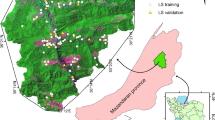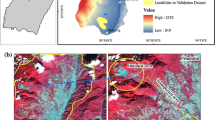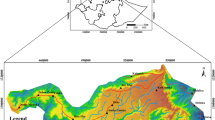Abstract
A remote sensing and geographic information system-based study has been carried out to map areas susceptible to landslides using three statistical models, frequency ratio (FR), logistic regression (LR), and fuzzy logic at the central Zab basin in the mountainsides in the southwest West Azerbaijan province in Iran. Ten factors such as slope, aspect, elevation, lithology, normalized difference vegetation index (NDVI), land cover, precipitation, distance to fault, distance to drainage, and distance to road were considered. Landsat ETM+ images were used for NDVI and land cover maps. A landslide inventory map of the study area was identified by a SPOT 5 satellite after which fuzzy algebraic operators were applied to the fuzzy membership values of landslide susceptibility mapping. In addition, FR and LR models were applied to determine the landslide susceptibility. The three models are validated using the receiver operating characteristic and the area under which curve values were calculated. The validation results showed that the LR model (accuracy is 96 %) has better prediction than fuzzy logic (accuracy is 95 %) and FR (accuracy is 94 %) models. Also, among the fuzzy operators, the gamma operator (λ = 0.975) showed the best accuracy (94.64 %) while the fuzzy OR operator when applied showed the worst accuracy (85.11 %).










Similar content being viewed by others
Change history
22 May 2023
A Correction to this paper has been published: https://doi.org/10.1007/s12665-023-10941-z
References
Aiken LS, West SG (1991) Multiple regression: testing and interpreting interactions. Sage, Canada
Akgün A, Bulut F (2007) GIS-based landslide susceptibility for Arsin–Yomra (Trabzon, North Turkey) region. Environ Geol 51:1377–1387
Akgun A, Dag S, Bulut F (2008) Landslide susceptibility mapping for a landslide-prone area (Findikli, NE of Turkey) by likelihood-frequency ratio and weighted linear combination models. Environ Geol 54:1127–1143
Akgun A, Kıncal C, Pradhan B (2012a) Application of remote sensing data and GIS for landslide risk assessment as an environmental threat to Izmir city (west Turkey). Environ Monit Assess 184:5453–5470
Akgun A, Sezer EA, Nefeslioglu HA, Gokceoglu C, Pradhan B (2012b) An easy-to-use MATLAB program (MamLand) for the assessment of landslide susceptibility using a Mamdani fuzzy algorithm. Comput Geosci 38:23–34
Ayalew L, Yamagishi H (2005) The application of GIS-based logistic regression for landslide susceptibility mapping in the Kakuda-Yahiko Mountains, Central Japan. Geomorphology 65:15–31
Bai S-B, Wang J, Lü G-N, Zhou P-G, Hou S-S, Xu S-N (2010) GIS-based logistic regression for landslide susceptibility mapping of the Zhongxian segment in the Three Gorges area, China. Geomorphology 115:23–31
Bai S, Lü G, Wang J, Zhou P, Ding L (2011) GIS-based rare events logistic regression for landslide-susceptibility mapping of Lianyungang, China. Environ Earth Sci 62:139–149
Bednarik M, Pauditš P (2010) Different ways of landslide geometry interpretation in a process of statistical landslide susceptibility and hazard assessment: Horná Súča (western Slovakia) case study. Environ Earth Sci 61:733–739
Bednarik M, Yilmaz I, Marschalko M (2012) Landslide hazard and risk assessment: a case study from the Hlohovec–Sered’ landslide area in south-west Slovakia. Nat Hazards 64:547–575
Bhandary NP, Dahal RK, Timilsina M, Yatabe R (2013) Rainfall event-based landslide susceptibility zonation mapping. Nat Hazards 1–24 doi:10.1007/s11069-013-0715-x
Biswajeet P, Saro L (2007) Utilization of optical remote sensing data and GIS tools for regional landslide hazard analysis using an artificial neural network model. Earth Sci Front 14:143–151
Bonham-Carter GF (1994) Geographic information systems for geoscientists: modelling with GIS, vol 13. Elsevier, Amsterdam
Brenning A (2005) Spatial prediction models for landslide hazards: review, comparison and evaluation. Nat Hazards Earth Syst Sci 5:853–862
Bui DT, Lofman O, Revhaug I, Dick O (2011) Landslide susceptibility analysis in the Hoa Binh province of Vietnam using statistical index and logistic regression. Nat Hazards 59:1413–1444
Burrough PA (1989) Fuzzy mathematical methods for soil survey and land evaluation. J Soil Sci 40:477–492
Burrough PA, McDonnell R, Burrough PA, McDonnell R (1998) Principles of geographical information systems, vol 333. Oxford University Press, Oxford
Burrough PA, van Gaans PF, MacMillan R (2000) High-resolution landform classification using fuzzy k-means. Fuzzy Sets Syst 113:37–52
Champatiray P, Dimri S, Lakhera R, Sati S (2007) Fuzzy-based method for landslide hazard assessment in active seismic zone of Himalaya. Landslides 4:101–111
Chauhan S, Sharma M, Arora M, Gupta N (2010) Landslide susceptibility zonation through ratings derived from artificial neural network. Int J Appl Earth Obs Geoinf 12:340–350
Chen C-Y, Huang W-L (2013) Land use change and landslide characteristics analysis for community-based disaster mitigation. Environ Monit Assess 185:1–15
Choi J, Oh H-J, Lee H-J, Lee C, Lee S (2012) Combining landslide susceptibility maps obtained from frequency ratio, logistic regression, and artificial neural network models using ASTER images and GIS. Eng Geol 124:12–23
Chung C-JF, Fabbri AG (1999) Probabilistic prediction models for landslide hazard mapping. Photogramm Eng Remote Sens 65:1389–1399
Clark WA, Hosking PL (1986) Statistical methods for geographers. Wiley, New York
Conforti M, Pascale S, Robustelli G, Sdao F (2014) Evaluation of prediction capability of the artificial neural networks for mapping landslide susceptibility in the Turbolo River catchment (northern Calabria, Italy). Catena 113:236–250
Constantin M, Bednarik M, Jurchescu MC, Vlaicu M (2011) Landslide susceptibility assessment using the bivariate statistical analysis and the index of entropy in the Sibiciu Basin (Romania). Environ Earth Sci 63:397–406
Cruden DM, Varnes DJ (1996) Landslide types and processes. In: Turner AK, Shuster RL (eds) Landslides: investigation and mitigation. Transportation Research Board, Washington DC, pp 36–75
Dai F, Lee C (2002) Landslide characteristics and slope instability modeling using GIS, Lantau Island, Hong Kong. Geomorphology 42:213–228
Dempster AP, Laird NM, Rubin DB (1977) Maximum likelihood from incomplete data via the EM algorithm. J R Stat Soc Ser B (Methodol) 39:1–38
Dubois D, Prade H (1990) Rough fuzzy sets and fuzzy rough sets. Int J Gen Syst 17:191–209
Dymond JR, Ausseil AG, Shepherd JD, Buettner L (2006) Validation of a region-wide model of landslide susceptibility in the Manawatu–Wanganui region of New Zealand. Geomorphology 74:70–79
Ercanoglu M, Gokceoglu C (2002) Assessment of landslide susceptibility for a landslide-prone area (north of Yenice, NW Turkey) by fuzzy approach. Environ Geol 41:720–730
Ercanoglu M, Gokceoglu C, Van Asch TW (2004) Landslide susceptibility zoning north of Yenice (NW Turkey) by multivariate statistical techniques. Nat Hazards 32:1–23
Ermini L, Catani F, Casagli N (2005) Artificial neural networks applied to landslide susceptibility assessment. Geomorphology 66:327–343
Feizizadeh B, Blaschke T, Nazmfar H, Rezaei Moghaddam M (2013) Landslide susceptibility mapping for the Urmia Lake basin, Iran: a multi-criteria evaluation approach using GIS. Int J Environ Res 7:319–336
Glade T (1998) Establishing the frequency and magnitude of landslide-triggering rainstorm events in New Zealand. Environ Geol 35:160–174
Gomez H, Kavzoglu T (2005) Assessment of shallow landslide susceptibility using artificial neural networks in Jabonosa River Basin, Venezuela. Eng Geol 78:11–27
Gorsevski PV, Gessler PE, Jankowski P (2003) Integrating a fuzzy k-means classification and a Bayesian approach for spatial prediction of landslide hazard. J Geogr Syst 5:223–251
Gorsevski PV, Jankowski P, Gessler PE (2005) Spatial prediction of landslide hazard using Fuzzy k-means and Dempster–Shafer theory. Trans GIS 9:455–474
Gorsevski PV, Gessler PE, Foltz RB, Elliot WJ (2006) Spatial prediction of landslide hazard using logistic regression and ROC analysis. Trans GIS 10:395–415
Gupta R, Joshi B (1990) Landslide hazard zoning using the GIS approach—a case study from the Ramganga catchment, Himalayas. Eng Geol 28:119–131
Irish RR, Barker JL, Goward SN, Arvidson T (2006) Characterization of the Landsat-7 ETM+ automated cloud-cover assessment (ACCA) algorithm. Photogramm Eng Remote Sens 72:1179–1188
Kääb A (2008) Remote sensing of permafrost-related problems and hazards. Permafr Periglac Process 19:107–136
Kanungo D, Arora M, Sarkar S, Gupta R (2006) A comparative study of conventional, ANN black box, fuzzy and combined neural and fuzzy weighting procedures for landslide susceptibility zonation in Darjeeling Himalayas. Eng Geol 85:347–366
Kawabata D, Bandibas J (2009) Landslide susceptibility mapping using geological data, a DEM from ASTER images and an Artificial Neural Network (ANN). Geomorphology 113:97–109
Kleinbaum DG, Klein M (2010) Maximum likelihood techniques: an overview. Logist regression statistics for biology and health. Springer, New York, pp 103–127
Lee S (2005) Application of logistic regression model and its validation for landslide susceptibility mapping using GIS and remote sensing data. Int J Remote Sens 26:1477–1491
Lee S (2007) Application and verification of fuzzy algebraic operators to landslide susceptibility mapping. Environ Geol 52:615–623
Lee S, Pradhan B (2007) Landslide hazard mapping at Selangor, Malaysia using frequency ratio and logistic regression models. Landslides 4:33–41
Lee S, Sambath T (2006) Landslide susceptibility mapping in the Damrei Romel area, Cambodia using frequency ratio and logistic regression models. Environ Geol 50:847–855
Lee S, Hwang J, Park I (2013) Application of data-driven evidential belief functions to landslide susceptibility mapping in Jinbu, Korea. Catena 100:15–30
MacMillan R, Pettapiece W, Nolan S, Goddard T (2000) A generic procedure for automatically segmenting landforms into landform elements using DEMs, heuristic rules and fuzzy logic. Fuzzy Sets Syst 113:81–109
Mathew J, Jha V, Rawat G (2007) Application of binary logistic regression analysis and its validation for landslide susceptibility mapping in part of Garhwal Himalaya, India. Int J Remote Sens 28:2257–2275
Mohammady M, Pourghasemi HR, Pradhan B (2012) Landslide susceptibility mapping at Golestan Province, Iran: a comparison between frequency ratio, Dempster–Shafer, and weights-of-evidence models. J Asian Earth Sci 61:221–236
Muthu K, Petrou M, Tarantino C, Blonda P (2008) Landslide possibility mapping using fuzzy approaches. Geosci Remote Sens IEEE Trans 46:1253–1265
Nagarajan R, Mukherjee A, Roy A, Khire M (1998) Technical note Temporal remote sensing data and GIS application in landslide hazard zonation of part of Western ghat, India. Int J Remote Sens 19:573–585
Nefeslioglu H, Gokceoglu C, Sonmez H (2008) An assessment on the use of logistic regression and artificial neural networks with different sampling strategies for the preparation of landslide susceptibility maps. Eng Geol 97:171–191
Oh H-J, Lee S (2011) Cross-application used to validate landslide susceptibility maps using a probabilistic model from Korea. Environ Earth Sci 64:395–409
Oh H-J, Pradhan B (2011) Application of a neuro-fuzzy model to landslide-susceptibility mapping for shallow landslides in a tropical hilly area. Comput Geosci 37:1264–1276
Ozdemir A (2009) Landslide susceptibility mapping of vicinity of Yaka Landslide (Gelendost, Turkey) using conditional probability approach in GIS. Environ Geol 57:1675–1686
Ozdemir A, Altural T (2012) A comparative study of frequency ratio, weights of evidence and logistic regression methods for landslide susceptibility mapping: Sultan Mountains, SW Turkey. J Asian Earth Sci 64:180–197
Peng L, Niu R, Huang B, Wu X, Zhao Y, Ye R (2014) Landslide susceptibility mapping based on rough set theory and support vector machines: a case of the Three Gorges area, China. Geomorphology 204:287–301
Pourghasemi HR, Pradhan B, Gokceoglu C (2012) Application of fuzzy logic and analytical hierarchy process (AHP) to landslide susceptibility mapping at Haraz watershed, Iran. Nat Hazards 63:965–996
Pourghasemi H, Moradi H, Aghda SF (2013) Landslide susceptibility mapping by binary logistic regression, analytical hierarchy process, and statistical index models and assessment of their performances. Nat Hazards 1–31. doi:10.1007/s11069-013-0728-5
Pourghasemi H, Moradi H, Aghda SF, Gokceoglu C, Pradhan B (2014) GIS-based landslide susceptibility mapping with probabilistic likelihood ratio and spatial multi-criteria evaluation models (North of Tehran, Iran). Arab J Geosci 7:1857–1878
Pradhan B (2010) Remote sensing and GIS-based landslide hazard analysis and cross-validation using multivariate logistic regression model on three test areas in Malaysia. Adv Space Res 45:1244–1256
Pradhan B (2011) Manifestation of an advanced fuzzy logic model coupled with Geo-information techniques to landslide susceptibility mapping and their comparison with logistic regression modelling. Environ Ecol Stat 18:471–493
Pradhan B (2013) A comparative study on the predictive ability of the decision tree, support vector machine and neuro-fuzzy models in landslide susceptibility mapping using GIS. Comput Geosci 51:350–365
Pradhan B, Lee S (2009) Landslide risk analysis using artificial neural network model focusing on different training sites. Int J Phys Sci 3:1–15
Pradhan B, Lee S (2010a) Delineation of landslide hazard areas on Penang Island, Malaysia, by using frequency ratio, logistic regression, and artificial neural network models. Environ Earth Sci 60:1037–1054
Pradhan B, Lee S (2010b) Landslide susceptibility assessment and factor effect analysis: backpropagation artificial neural networks and their comparison with frequency ratio and bivariate logistic regression modelling. Environ Model Softw 25:747–759
Regmi AD, Yoshida K, Pourghasemi HR, DhitaL MR, Pradhan B (2014) Landslide susceptibility mapping along Bhalubang–Shiwapur area of mid-Western Nepal using frequency ratio and conditional probability models. J Mt Sci 11:1266–1285
Saboya F Jr, da Glória Alves M, Dias Pinto W (2006) Assessment of failure susceptibility of soil slopes using fuzzy logic. Eng Geol 86:211–224
Saito H, Nakayama D, Matsuyama H (2009) Comparison of landslide susceptibility based on a decision-tree model and actual landslide occurrence: the Akaishi Mountains. Jpn Geomorphol 109:108–121
Sarkar S, Kanungo D (2004) An integrated approach for landslide susceptibility mapping using remote sensing and GIS. Photogramm Eng Remote Sens 70:617–625
Sezer EA, Pradhan B, Gokceoglu C (2011) Manifestation of an adaptive neuro-fuzzy model on landslide susceptibility mapping: Klang valley, Malaysia. Expert Syst Appl 38:8208–8219
Shahabi H, Ahmad B, Khezri S (2013) Evaluation and comparison of bivariate and multivariate statistical methods for landslide susceptibility mapping (case study: Zab basin). Arab J Geosci 6:3885–3907
Shahabi H, Khezri S, Ahmad BB, Musa TA (2014) Application of moderate resolution imaging spectroradiometer snow cover maps in modeling snowmelt runoff process in the central Zab basin, Iran. J Appl Remote Sens 8:084699
Stefanakis E, Vazirgiannis M, Sellis T (1999) Incorporating fuzzy set methodologies in a DBMS repository for the application domain of GIS. Int J Geogr Inf Sci 13:657–675
Süzen ML, Doyuran V (2004a) A comparison of the GIS based landslide susceptibility assessment methods: multivariate versus bivariate. Environ Geol 45:665–679
Süzen ML, Doyuran V (2004b) Data driven bivariate landslide susceptibility assessment using geographical information systems: a method and application to Asarsuyu catchment, Turkey. Eng Geol 71:303–321
Tien Bui D, Pradhan B, Lofman O, Revhaug I, Dick OB (2012) Landslide susceptibility mapping at Hoa Binh province (Vietnam) using an adaptive neuro-fuzzy inference system and GIS. Comput Geosci 45:199–211
Van Den Eeckhaut M, Vanwalleghem T, Poesen J, Govers G, Verstraeten G, Vandekerckhove L (2006) Prediction of landslide susceptibility using rare events logistic regression: a case-study in the Flemish Ardennes (Belgium). Geomorphology 76:392–410
Van Westen CJ (1994) GIS in landslide hazard zonation: a review, with examples from the Andes of Colombia. In: Price MF, Heywood DI (eds) Mountain environments and geographic information systems. Taylor and Francis Publishers, London, pp 135–166
Wang L-J, Sawada K, Moriguchi S (2013) Landslide susceptibility analysis with logistic regression model based on FCM sampling strategy. Comput Geosci 57:81–92
Xu C et al (2013) Application of an incomplete landslide inventory, logistic regression model and its validation for landslide susceptibility mapping related to the May 12, 2008 Wenchuan earthquake of China. Nat Hazards 68:1–18
Xu C, Dai F, Xu X, Lee YH (2012) GIS-based support vector machine modeling of earthquake-triggered landslide susceptibility in the Jianjiang River watershed, China. Geomorphology 145:70–80
Yalcin A, Reis S, Aydinoglu A, Yomralioglu T (2011) A GIS-based comparative study of frequency ratio, analytical hierarchy process, bivariate statistics and logistics regression methods for landslide susceptibility mapping in Trabzon, NE Turkey. Catena 85:274–287
Yao X, Tham L, Dai F (2008) Landslide susceptibility mapping based on support vector machine: a case study on natural slopes of Hong Kong, China. Geomorphology 101:572–582
Yeon Y-K, Han J-G, Ryu KH (2010) Landslide susceptibility mapping in Injae, Korea, using a decision tree. Eng Geol 116:274–283
Yesilnacar E, Topal T (2005) Landslide susceptibility mapping: a comparison of logistic regression and neural networks methods in a medium scale study, Hendek region (Turkey). Eng Geol 79:251–266
Yilmaz I (2009) Landslide susceptibility mapping using frequency ratio, logistic regression, artificial neural networks and their comparison: a case study from Kat landslides (Tokat–Turkey). Comput Geosci 35:1125–1138
Yilmaz I (2010) Comparison of landslide susceptibility mapping methodologies for Koyulhisar, Turkey: conditional probability, logistic regression, artificial neural networks, and support vector machine. Environ Earth Sci 61:821–836
Zadeh LA (1965) Fuzzy sets information and control. Inf control 8:338–353
Zimmermann HJ (2001) Fuzzy set theory-and its applications. Springer, Berlin
Acknowledgments
This study was conducted as a part of post-doctoral fellowship scheme granted by Universiti Teknologi Malaysia (UTM). The authors would like to thank the anonymous reviewers for the constructive comments which significantly improved the quality of this paper. We are also grateful to the Dr. Gunter Doerhoefer (Editors-in-Chief) for their helpful comments and suggestions that enabled us to improve the paper.
Author information
Authors and Affiliations
Corresponding author
Rights and permissions
About this article
Cite this article
Shahabi, H., Hashim, M. & Ahmad, B.B. Remote sensing and GIS-based landslide susceptibility mapping using frequency ratio, logistic regression, and fuzzy logic methods at the central Zab basin, Iran. Environ Earth Sci 73, 8647–8668 (2015). https://doi.org/10.1007/s12665-015-4028-0
Received:
Accepted:
Published:
Issue Date:
DOI: https://doi.org/10.1007/s12665-015-4028-0




